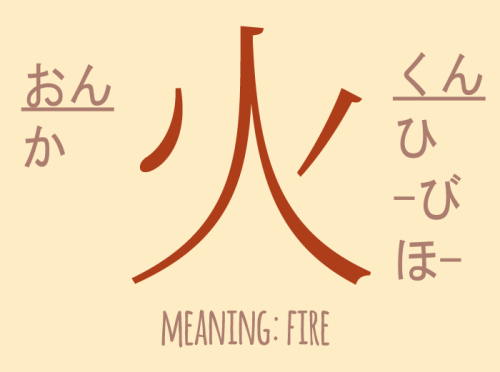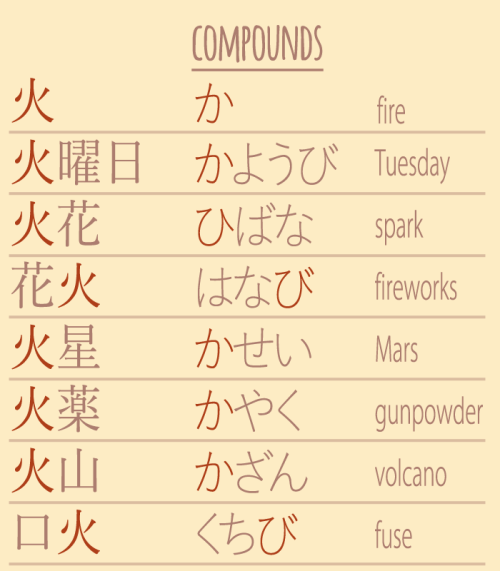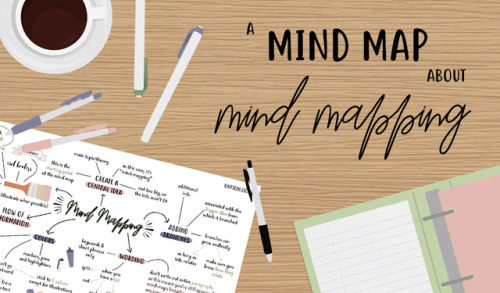Some Compounds Of One Of My Favourite Kanji, 火


some compounds of one of my favourite kanji, 火
More Posts from Earthquakedeer and Others
白い目で見る
しろいめでみる
to look coldly at; to turn a cold shoulder
彼は性格が悪いのでみんなが白い目で見ています。 かれ は せいかく が わるい ので みんな が しろいめでみています。 Because he has a bad personality, everyone looks at him scornfully.
(人)を白い目で見る: look at someone with disapproval / regard someone with disdain
25 Japanese words for clothing items

1。 ベルト [beruto] ~ belt
2。母子 [bōshi] ~ cap; hat
3。ブラジャー [burajā] ~ bra
4。ブリーフ [burīfu] ~ briefs; men’s underwear
5。ドレス [doresu] ~ dress
6。ジャケット [jaketto] ~ jacket
7。ジーンズ [jīnzu] ~ jeans
8。コート [kōto] ~ coat
9。靴 [kutsu] ~ shoes
10。靴下 [kutsushita] ~ socks
11。ネクタイ [nekutai] ~ neck tie
12。サングラス [sangurasu] ~ sunglasses
13。セーター [sētā] ~ sweater
14。シャツ [shatsu] ~ shirt
15。スカート [sukāto] ~ skirt
16。スーツ [sūtsu] ~ suit
17。スニーカー [sunīkā] ~ sneakers
18。トランクス [torankusu] ~ boxers; men’s underwear
19。ズボン [zubon] ~ pants
20。手袋 [tebukuro] ~ gloves
21。スカーフ [sukāfu] ~ scarf
22。宝石 [hōseki] ~ jewelry
23。水着 [mizugi] ~ swimsuit
24。パジャマ [pajama] ~ pajamas
25。服 [fuku] ~ clothes





Peace of mind.


Küchenwaren - Kitchen supplies
der Beutel – bag die Flasche - bottle der Flaschenöffner – bottle opener das Becken – bowl die Schachtel - box die Kuchenform – cake pans die Dose – can der Büchsenöffner – can opener die Tüte – carton die Küchenreibe – cheese grater die Essstäbchen – chopsticks die Kaffeekanne – coffee pot das Sieb – colander, strainer der Korkenzieher – corkscrew die Tasse – cup das Schneidbrett – cutting board die Schüssel – dish das Geschirrtuch – dish towel die Gabel – fork die Bratpfanne – frying pan das Glas – glass der Eiswürfelbehälter – ice tray die Flasche – jar der Krug – jug der Kessel – kettle das Messer – knife der Deckel - lid die Messbecher – measuring cup die Messlöffel – measuring spoons die Serviette – napkin der Topfhandschuh – oven mitt der Teller – plate der Topf – pot der Schnellkochtopf – pressure cooker das Nudelholz – rolling pin der Kochtopf – saucepan die Untertasse – saucer das Besteck – silverware der Spachtel – spatula der Löffel – spoon der Vorratstopf – stock pot der Tisch – table die Tischdecke – tablecloth der Teekessel – tea kettle die Tube – tube der Schneebesen - whisk



A MIND MAP ABOUT MIND-MAPPING
If you know me, you’d know that I am a highly visual person. I love learning from images and layouts, and my spatial intelligence is probably my strongest type of intelligence. Because of this, I often use mind maps to study, and so do a lot of other people. However, there are people who don’t really know how to make and utilize a mind map effectively. That’s what this post is for! Here’s how you can make your mind maps more effective and thus enable you to retain more information. (P.S. you might wanna zoom in)
By no means am I an expert in mind-mapping; these are just some habits I have when making a mind map that successfully does its job of helping me remember the topics I’m studying.
If you have any questions, feel free to drop an ask!
xx jo









GENKI I: LESSON 3 NOTES
whoo. this lesson was long and hard. it took me around 12 hours over 4 days. most of the time was spent in the grammar section trying to understand all the particles that were thrown at you this lesson. nevertheless, i persevered and finished the workbook a few hours ago. this lesson also started giving kanji, which added extra time. i really love using jisho.org to look up kanji meanings and the stroke order. the interface is very nice and i highly recommend it! onward to lesson 4! how was your guys’ week?
genki lesson 3/12 countdown to JLPT N5 exam on dec. 3rd - 77 days

yoyogi-uehara 12:58:56
english: one million
japanese: :)
english: oh boy
japanese: one hundred ten thousands
-
 cutiebelle1 liked this · 9 months ago
cutiebelle1 liked this · 9 months ago -
 thepathoftheforest liked this · 2 years ago
thepathoftheforest liked this · 2 years ago -
 exhaustedaesthetic liked this · 3 years ago
exhaustedaesthetic liked this · 3 years ago -
 paprikal1ps liked this · 4 years ago
paprikal1ps liked this · 4 years ago -
 r-memoirs liked this · 5 years ago
r-memoirs liked this · 5 years ago -
 rubieeg-blog liked this · 6 years ago
rubieeg-blog liked this · 6 years ago -
 madowluno liked this · 7 years ago
madowluno liked this · 7 years ago -
 khollda-blog reblogged this · 7 years ago
khollda-blog reblogged this · 7 years ago -
 madowlune-blog liked this · 7 years ago
madowlune-blog liked this · 7 years ago -
 nihongo-reminders reblogged this · 7 years ago
nihongo-reminders reblogged this · 7 years ago -
 rosebadwolf1000 liked this · 7 years ago
rosebadwolf1000 liked this · 7 years ago -
 inazuma-eleven-translations liked this · 7 years ago
inazuma-eleven-translations liked this · 7 years ago -
 daydreamerbeautiful liked this · 7 years ago
daydreamerbeautiful liked this · 7 years ago -
 micsmays1031 reblogged this · 7 years ago
micsmays1031 reblogged this · 7 years ago -
 goodnightsaltyprince reblogged this · 7 years ago
goodnightsaltyprince reblogged this · 7 years ago -
 earthquakedeer reblogged this · 7 years ago
earthquakedeer reblogged this · 7 years ago -
 studyingpotatos liked this · 7 years ago
studyingpotatos liked this · 7 years ago -
 pancakejapanese reblogged this · 7 years ago
pancakejapanese reblogged this · 7 years ago -
 libroprincipessa reblogged this · 7 years ago
libroprincipessa reblogged this · 7 years ago -
 oslez-blog liked this · 7 years ago
oslez-blog liked this · 7 years ago -
 magic-dustt liked this · 7 years ago
magic-dustt liked this · 7 years ago -
 neul-nim reblogged this · 7 years ago
neul-nim reblogged this · 7 years ago -
 kodonacupcake liked this · 7 years ago
kodonacupcake liked this · 7 years ago -
 justlanguages-blog reblogged this · 8 years ago
justlanguages-blog reblogged this · 8 years ago -
 captain-nihongo-blog reblogged this · 8 years ago
captain-nihongo-blog reblogged this · 8 years ago -
 icedmwtcha liked this · 8 years ago
icedmwtcha liked this · 8 years ago -
 autumnrainwitch liked this · 8 years ago
autumnrainwitch liked this · 8 years ago -
 fairboundfield liked this · 8 years ago
fairboundfield liked this · 8 years ago -
 fairboundfield reblogged this · 8 years ago
fairboundfield reblogged this · 8 years ago -
 freefallenangels liked this · 8 years ago
freefallenangels liked this · 8 years ago -
 k-i-tten liked this · 8 years ago
k-i-tten liked this · 8 years ago -
 owawaaa liked this · 8 years ago
owawaaa liked this · 8 years ago -
 saayrin liked this · 8 years ago
saayrin liked this · 8 years ago -
 westleywestwest-blog liked this · 8 years ago
westleywestwest-blog liked this · 8 years ago -
 morskijamnik liked this · 8 years ago
morskijamnik liked this · 8 years ago -
 zombielordtaewoon liked this · 8 years ago
zombielordtaewoon liked this · 8 years ago -
 semjaishi-roman-blog liked this · 8 years ago
semjaishi-roman-blog liked this · 8 years ago -
 rozensword liked this · 8 years ago
rozensword liked this · 8 years ago -
 cxytournesol liked this · 8 years ago
cxytournesol liked this · 8 years ago
Just a person learning Japanese. Self-learner. If you're also studying Japanese and want to practice with someone (and you're also very much a beginner) then message me! はじめまして! さびーなです。よとしく!
196 posts